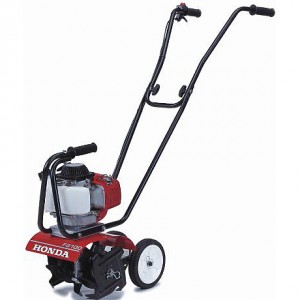After tilling your garden this fall to turn over sod and mix in organic matter, it will be time to put your Honda tiller into storage. Taking steps to protect your equipment now will make it easier to get it up and running in the spring.
Inspection
Addressing issues now will mean your tiller will be ready to work when it’s time to break ground in the spring. Give your machine a look over and answer these questions:
Are the tines straight? Do they show severe wear or signs of cracking?
If the tiller has a belt drive, is the belt still tight? Is it starting to crack?
Is the spark plug, fuel hose, and air filter still in good condition?
Cleaning
Let the engine cool for at least a half hour before cleaning: rapid cooling caused by water making contact with hot engine parts can cause warping.
A garden hose or pressure washer can be used, but the water should not be aimed at the controls, cables, air filter, belts or muffler. A rag or stiff brush can be used to remove dirt trapped near these sensitive areas.
Once clean, wipe any remaining moisture off of the tiller. To get rid of the last bit of water, start the engine and let it run until it reaches normal operating temperature. If the mower has a clutch, operate the clutch lever several times to remove any water clinging to the pulleys and belts.
Fuel
Even stabilized fuel should not be kept in your tiller’s engine for longer than three months. Before putting it into long term storage, the fuel system should be drained completely.
Start by disconnecting the spark plug. If there is an engine switch, make sure it’s set to “off.”
On models with a Mini 4-Stroke engine, open the gas cap and tip the tiller so that the gas pours out into a container. Once the tank is empty, squeeze the priming bulb to remove any remaining gas in the carburetor.
On models with larger engines, place a fuel container underneath the carburetor and unscrew the gas cap. Open the fuel valve and unscrew the fuel drain bolt or knob at the bottom of the carburetor. Newer models like the FC 600 also have a sediment cup to the right of the drain knob: once the fuel has drained, unscrew this cup, clean out any fuel and debris, and reinstall the cup, fitting a new O-ring to ensure a tight seal. Screw the bolt or knob back into the carburetor once the tank and carburetor are empty.
Oil
If your tiller has a separate transmission, the fluid inside does not need attention before you put your equipment in storage aside from checking the level. On all models, the engine oil should be changed, and the cylinder should be lubricated to prevent rust.
To lubricate the cylinder, first, remove the spark plug.
For Mini 4 Stroke engines, pour a quarter teaspoon of clean engine oil into the spark plug hole. For other engines, add one teaspoon of oil.
Pull the starter handle several times to circulate the oil inside the cylinder, then reinstall the spark plug.
Pull the starter handle gently until resistance is felt. This positions the valve train so that both the intake and exhaust valves are closed, sealing the combustion chamber.
When the tiller is put back into service, it’s normal for the motor to smoke for a few seconds as the oil in the cylinder is burnt off.
Rust Prevention
To keep rust from forming during storage, chipped and damaged paint should be covered in a touch-up paint, while bare metal surfaces should get a light coat of oil or silicone lubricant.
Storing
Even with the fuel tank and carburetor drained, there may still be enough fuel inside of your tiller to release flammable vapors. Keep the tiller in an area that doesn’t have an open flame or sparks nearby. This includes avoiding power tools, heaters, clothes dryers and water heaters.
To prevent rust, the tiller should be stored in an area with low humidity. Placing a tarp over the tiller can trap moisture, accelerating rust formation.
If you fold the handle to make the tiller more compact, make sure the cables aren’t kinked or wedged between the upper and lower handle.
Getting Parts for Your Honda Tiller
From small maintenance parts like O-rings and spark plugs up to major components including tines and engine covers, if it’s Honda, you can find it at Hondalawnparts.com. We’re a certified Honda Small Engine and Power Equipment dealer, and our massive parts stock lets us ship parts quickly across the U.S. and Canada.

